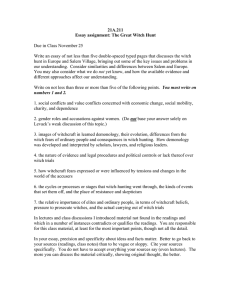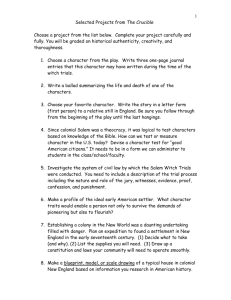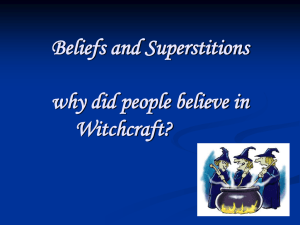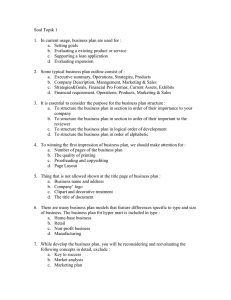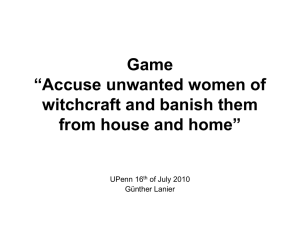Lanier.Gunther - GL ExecutiveSummary WitchesInGames
advertisement
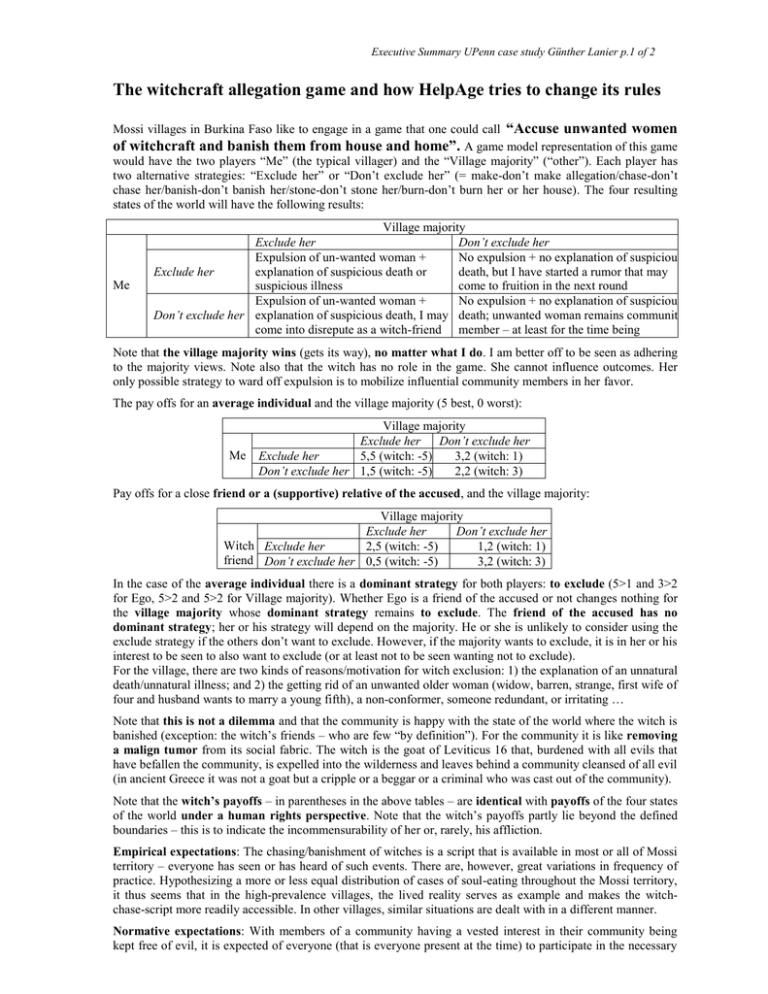
Executive Summary UPenn case study Günther Lanier p.1 of 2 The witchcraft allegation game and how HelpAge tries to change its rules Mossi villages in Burkina Faso like to engage in a game that one could call “Accuse unwanted women of witchcraft and banish them from house and home”. A game model representation of this game would have the two players “Me” (the typical villager) and the “Village majority” (“other”). Each player has two alternative strategies: “Exclude her” or “Don’t exclude her” (= make-don’t make allegation/chase-don’t chase her/banish-don’t banish her/stone-don’t stone her/burn-don’t burn her or her house). The four resulting states of the world will have the following results: Me Village majority Exclude her Don’t exclude her Expulsion of un-wanted woman + No expulsion + no explanation of suspicious Exclude her explanation of suspicious death or death, but I have started a rumor that may suspicious illness come to fruition in the next round Expulsion of un-wanted woman + No expulsion + no explanation of suspicious Don’t exclude her explanation of suspicious death, I may death; unwanted woman remains community come into disrepute as a witch-friend member – at least for the time being Note that the village majority wins (gets its way), no matter what I do. I am better off to be seen as adhering to the majority views. Note also that the witch has no role in the game. She cannot influence outcomes. Her only possible strategy to ward off expulsion is to mobilize influential community members in her favor. The pay offs for an average individual and the village majority (5 best, 0 worst): Me Village majority Exclude her Don’t exclude her Exclude her 5,5 (witch: -5) 3,2 (witch: 1) Don’t exclude her 1,5 (witch: -5) 2,2 (witch: 3) Pay offs for a close friend or a (supportive) relative of the accused, and the village majority: Village majority Exclude her Don’t exclude her Witch Exclude her 2,5 (witch: -5) 1,2 (witch: 1) friend Don’t exclude her 0,5 (witch: -5) 3,2 (witch: 3) In the case of the average individual there is a dominant strategy for both players: to exclude (5>1 and 3>2 for Ego, 5>2 and 5>2 for Village majority). Whether Ego is a friend of the accused or not changes nothing for the village majority whose dominant strategy remains to exclude. The friend of the accused has no dominant strategy; her or his strategy will depend on the majority. He or she is unlikely to consider using the exclude strategy if the others don’t want to exclude. However, if the majority wants to exclude, it is in her or his interest to be seen to also want to exclude (or at least not to be seen wanting not to exclude). For the village, there are two kinds of reasons/motivation for witch exclusion: 1) the explanation of an unnatural death/unnatural illness; and 2) the getting rid of an unwanted older woman (widow, barren, strange, first wife of four and husband wants to marry a young fifth), a non-conformer, someone redundant, or irritating … Note that this is not a dilemma and that the community is happy with the state of the world where the witch is banished (exception: the witch’s friends – who are few “by definition”). For the community it is like removing a malign tumor from its social fabric. The witch is the goat of Leviticus 16 that, burdened with all evils that have befallen the community, is expelled into the wilderness and leaves behind a community cleansed of all evil (in ancient Greece it was not a goat but a cripple or a beggar or a criminal who was cast out of the community). Note that the witch’s payoffs – in parentheses in the above tables – are identical with payoffs of the four states of the world under a human rights perspective. Note that the witch’s payoffs partly lie beyond the defined boundaries – this is to indicate the incommensurability of her or, rarely, his affliction. Empirical expectations: The chasing/banishment of witches is a script that is available in most or all of Mossi territory – everyone has seen or has heard of such events. There are, however, great variations in frequency of practice. Hypothesizing a more or less equal distribution of cases of soul-eating throughout the Mossi territory, it thus seems that in the high-prevalence villages, the lived reality serves as example and makes the witchchase-script more readily accessible. In other villages, similar situations are dealt with in a different manner. Normative expectations: With members of a community having a vested interest in their community being kept free of evil, it is expected of everyone (that is everyone present at the time) to participate in the necessary Executive Summary UPenn case study Günther Lanier p.2 of 2 cleansing exercise. Procedures need to be followed, but with the witch proven to be the culprit (e.g. by “siongo” or poison ordeal), the removal of the culprit is a logical consequence. The typical villager is expected to participate in this salutary event – like everybody else. Sanctions: Free-riding is not a problem. Non-participants miss out on a joyful event of intoxicating togetherness, where participants cannot but win – the opponent being alone and weak. Non-participation would not need punishment. However, if somebody is perceived to not participate, this may raise suspicions about her or him being an ally of the persecuted, meaning that she or he might also be a witch. This might – immediately or later on – lead to witchcraft allegations against the concerned, and we know what dangers this entails. Social norm: If a person (mostly a woman) has been proven guilty of practicing witchcraft (soul-eating), that person (usually a woman) is to be banished from the village or killed. With empirical and normative expectations as well as sanctions in place, this is clearly a social norm. Scripts: The chasing of witches is a script in itself. It harmonizes/fits in well with the script of “womanhood”, which includes the perception of woman as the eternal other/ stranger: in her family of origin because she will leave to go and live with her husband’s family (patrilocality), and in the home of her husband because she is from elsewhere and her real affiliation is thought/expected to be with her family of origin. The witch banishment norm also harmonizes well with the woman submission norm (with beating of women – largely thought justified by burkinabè women themselves/see MICS 2006 – a sub-norm) and further reinforces the high value assigned to woman servility. The norm and practice also reinforce the underlying value of conformity/not standing out in the crowd, that helps prevent dangerous individualism. Note that there is a certain contradiction, between the witchcraft script and the generally almost excessive weight and worth of blood and family relations: the African witchcraft schema has close relatives as the most endangered – small children in the first place, but husband deaths are often triggers for witchcraft allegations. Witchcraft allegations thus undermine family solidarity. They at the same time provide an outlet for intrafamiliar tensions that would otherwise not be admissible and, even less, voiceable. From all this it is clear that witchcraft allegations are a community practice. Addressing it on an individual level will be pretty useless – as is clearly visible in the payoff matrix for the typical villager or also the witch friend. If change there shall be, it will need to happen on a community level. “Promote senior women’s rights and their access to social benefits in Burkina Faso” is a three-year project financed by the European Union, 2009-2011. The implementing agency is Help Age International. With three national implementing partners (PFDS, CRBF, APF), the target localities are Arbollé and Thema Bokin departments of Passoré province (about 100 km north-west of the capital Ouagadougou). With the promotion of seniors’ (especially senior women’s) rights and their access to social benefits as the overall aim, the project more specifically sets out to reduce social exclusion and violation of senior women’s rights in Burkina Faso. Multi-pronged activities reaching from activities aiming for senior women’s empowerment to lobbying and advocacy on the local, provincial and national level are planned and have been implemented since the launch of the project in March 2009. A tentative first evaluation: The project is holistic, deals with the problem on the several levels involved, works in important parts close to the basis, is human rights-based and aims at the empowerment of the concerned. When measuring the project’s activities against suggestions of the social convention/social norm theory, it seems that network analysis could help (identification/mapping of individuals in risk of social exclusion, gossip and the respect/influence networks). The core group of initial changers would be the project’s paralegals. Critical mass should be defined as a group big & influential enough to successfully oppose attempts at chasing witches when the village majority wants to exclude. The gateway chosen by the project - human and women rights – is correct. Stress the value of solidarity, push for this concept to include all members of the community, deal with social tensions and problems when they are still small, fostering talk and communication amongst the concerned, with mediation if necessary, thus confronting exclusion in its nascent stage. Given the breadth of the network of beliefs/values/practices that embed witchcraft allegations, a holistic approach makes more than sense. Besides information & counseling on human rights, literacy training is a cornerstone of the HelpAge project, many other activities are planned, concerning health and hygiene etc. Revenue generating activities for the women in danger but also for the communities they live in could be of help. Genuine community discussion, community decision and – most of all, although only after careful preparation – public community commitment are probably elements that are missing in the HelpAge project.

